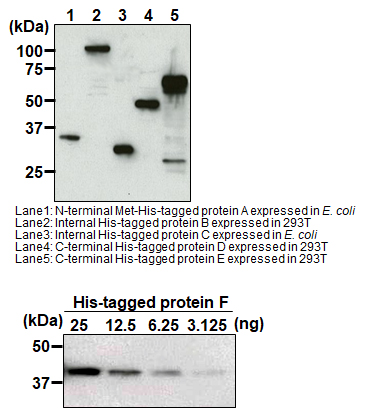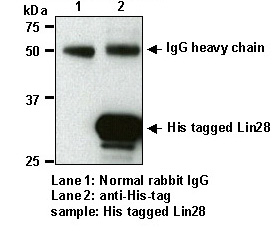- Japan(Japanese / English)
- Global
- MBL TOP
- MBL site search
Close
This site is for customers in Japan.
Customers in other regions, please go to Global page.
HOME >
Product search results > Code No. D291-3
Anti-His-tag mAb
Price
¥52,800
Availability (in Japan)
10 or more
(In Japan at 00:05,
Apr 20, 2024 in JST)
Size
200 µL (1 mg/mL)
| Data | |||||
|---|---|---|---|---|---|
| Clonality | Monoclonal | Clone | OGHis | ||
| Isotype (Immunized Animal) | Mouse IgG2aκ | ||||
| Applications | |||||
| Immunogen (Antigen) | 6xHis-tagged protein | ||||
| Storage buffer | 1 mg/mL in PBS/50% glycerol, pH 7.2 | ||||
| Storage temp. | -20°C | Conjugate | Unlabeled | Manufacturer | MBL |
| Background | The His-tag (6xHis-tag) is one of the most common tags used to facilitate the purification of recombinant proteins. Metal chelate affinity chromatography is widely used for purification of His-tagged proteins. This specific antibody is useful tool for monitoring of the His-tagged proteins, and recognizes His-tags placed at N-terminal, C-terminal, and internal regions of the recombinant proteins. | ||||
| Related products | PM032 Anti-His-tag pAb PM032-8 Anti-His-tag pAb-Agarose D291-6 Anti-His-tag mAb-Biotin D291-7 Anti-His-tag mAb-HRP-DirecT D291-8 Anti-His-tag mAb-Agarose D291-10 Anti-His-tag mAb-Magnetic Agarose D291-A48 Anti-His-tag mAb-Alexa Fluor™ 488 D291-A59 Anti-His-tag mAb-Alexa Fluor™ 594 D291-A64 Anti-His-tag mAb-Alexa Fluor™ 647 M089-3 Anti-His-tag mAb M136-3 Anti-His-tag mAb D291-11 Anti-His-tag mAb-Magnetic Beads |
||||
| Citations |
Western Blotting
Co-IP
Immunoprecipitation
Immunocytochemistry
|
||||
| Product category |
|
||||
- The availability is based on the information in Japan at 00:05, Apr 20, 2024 in JST.
- The special price is shown in red color.
- Please note that products cannot be ordered from this website. To purchase the items listed in this website, please contact us or local distributers.
- Abbreviations for applications:
WB: Western Blotting, IH: Immunohistochemistry, IC: Immunocytochemistry, IP: Immunoprecipitation
FCM: Flow Cytometry, NT: Neutralization, IF: Immunofluorescence, RIP: RNP Immunoprecipitation
ChIP: Chromatin Immunoprecipitation, CoIP: Co-Immunoprecipitation
DB: Dot Blotting, NB: Northern Blotting, RNA FISH: RNA Fluorescence in situ hybridization - For applications and reactivity:
*: The use is reported in a research article (Not tested by MBL). Please check the data sheet for detailed information.
**: The use is reported from the licenser (Under evaluation or not tested by MBL).
- For storage temparature: RT: room temparature
- Please note that products in this website might be changed or discontinued without notification in advance for quality improvement.











 Citations
Citations Data Sheet
Data Sheet





